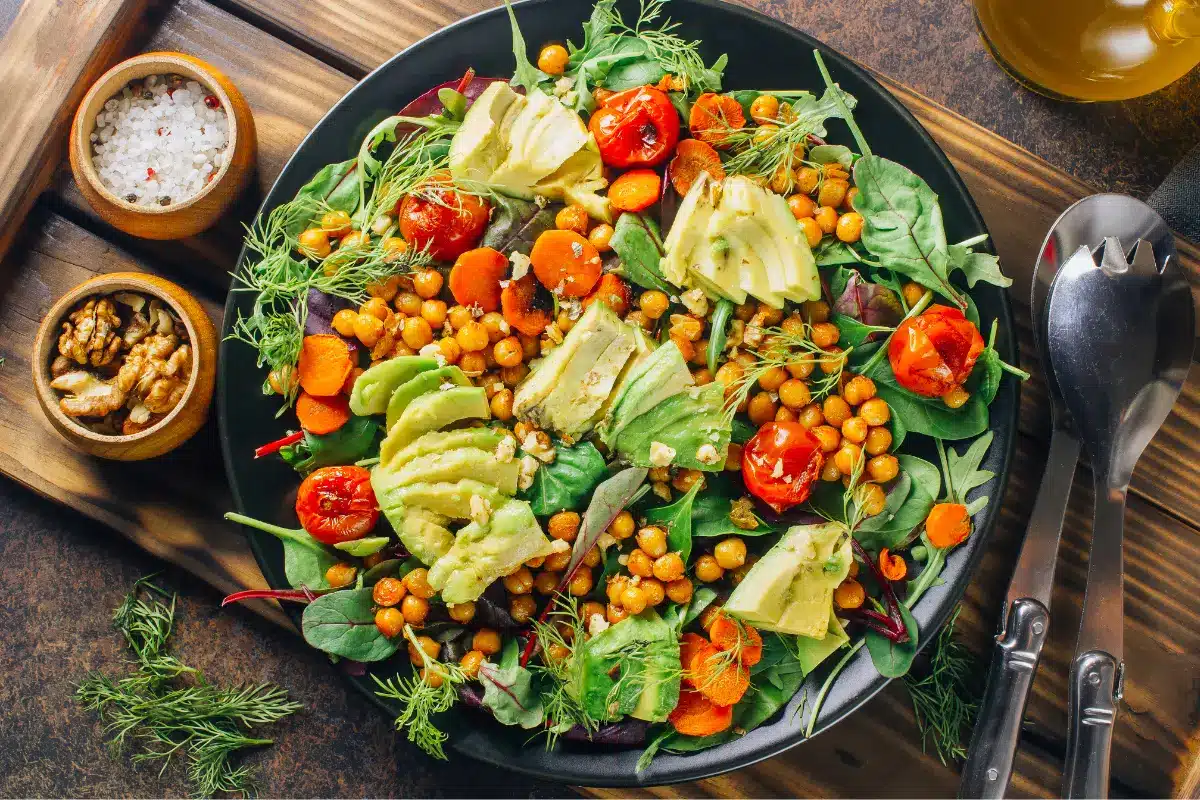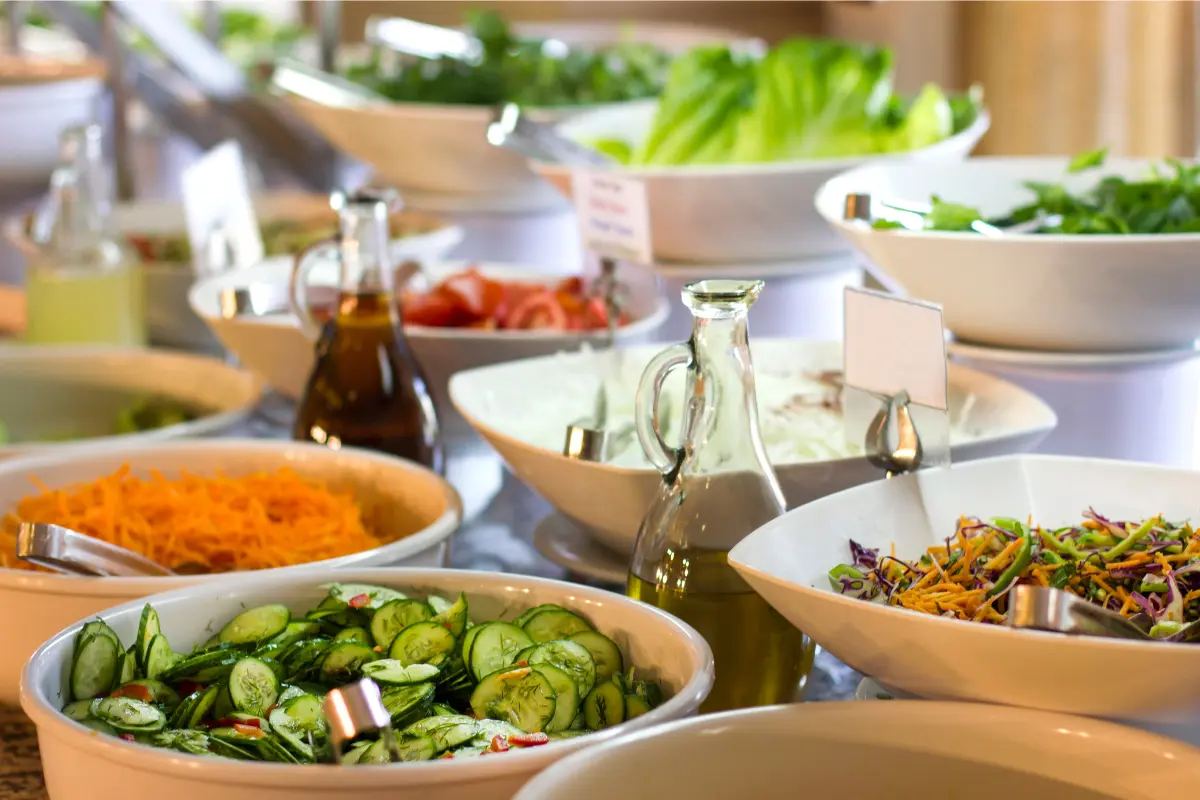In the bustling world of culinary delights, the humble salad bar holds its ground as a beacon of health, variety, and creativity. Gone are the days when salads were mere side dishes; today, they take center stage, offering a canvas for flavors, textures, and nutrients. This article dives deep into the art of crafting the ultimate salad bar at home. From the crisp base of greens to the zesty punch of dressings, we’ll guide you through each step, ensuring your salad bar is nothing short of spectacular. Whether you’re catering to a crowd or simply spicing up your meal routine, these insights will transform your approach to salads, making every bite a celebration of fresh, vibrant ingredients.
What is a Salad Bar?
Imagine a buffet of colors, textures, and flavors, all waiting to be combined into your perfect plate of salad. That’s the essence of a salad bar. It’s a culinary setup where guests can mix and match ingredients to create their ideal salad. The beauty of a salad bar lies in its diversity; it caters to all tastes and dietary preferences, making it a hit in both homes and restaurants alike.
Benefits of Creating a Salad Bar at Home
First off, the customization is unbeatable. Whether you’re a fan of baby spinach or can’t get enough of crunchy croutons, there’s something for everyone. Plus, it’s a fantastic way to encourage a balanced diet. Piling your plate with a rainbow of vegetables? Yes, please! And let’s not forget the social aspect. A salad bar turns meals into interactive experiences, bringing people together as they share their unique creations.
The Evolution of Salad Bars
From their humble beginnings in restaurants, salad bars have come a long way. Initially, they were simple – a few greens here, some toppings there. But as our palates evolved, so did the salad bar. Today, they’re a testament to global flavors and ingredients, offering everything from quinoa to edamame. This evolution reflects our growing desire for meals that are not only healthy but also high on flavor and variety.
So, why not bring this culinary adventure into your home? With a bit of planning and some fresh ingredients, you can set up a salad bar that rivals any restaurant’s. Stay tuned as we delve into the nuts and bolts of creating your very own salad bar, ensuring your next meal is a vibrant celebration of fresh, nutritious, and delicious choices.
Before we dive into the heart of creating your very own salad bar at home, let’s take a moment to appreciate the beauty and versatility of salads. They’re not just a side dish; they’re a canvas for creativity, a medley of textures and flavors that can transform a simple meal into an extraordinary experience. In this comprehensive guide, we’ll explore how to set up a salad bar that caters to every taste, dietary preference, and occasion. From the crisp base of greens to the zesty punch of dressings, we’re covering all the bases to help you craft the ultimate salad bar experience. So, grab your favorite bowl, and let’s get started!
Setting Up Your Salad Bar
Choosing the Right Ingredients
When it comes to assembling a salad bar, the key lies in offering a variety of options that cater to everyone’s tastes and preferences. Here’s how you can set up a salad bar that’s sure to impress:
- Base Ingredients
- Romaine lettuce
- Spring mixed salad greens
- Baby spinach leaves
Ah, the foundation of any good salad! Choosing a mix of greens not only adds a variety of textures but also ensures that there’s something for everyone. Whether your guests prefer the crispness of romaine or the tenderness of baby spinach, a well-thought-out selection is the first step to a successful salad bar.
- Protein Options
- Cooked chicken breasts, sliced
- Cooked tofu
- Chopped ham
- Crispy bacon, chopped
- Hard-boiled eggs, sliced
Protein is paramount, and offering a range from meat to plant-based options like tofu ensures that your salad bar is a hit with both carnivores and vegetarians alike. It’s all about balance and choice, after all!
- Vegetable Toppings
- Avocados, sliced
- Carrots, grated
- Frozen peas, thawed
- Cucumbers, sliced
- Cherry tomatoes, halved
Vegetables add color, crunch, and, most importantly, nutrition to your salad bar. By offering a rainbow of veggies, you’re not just making your salad bar more appealing; you’re also boosting its health quotient.
- Cheese and Extras
- Feta cheese, crumbled
- Parmesan cheese, shredded
- Cheddar cheese, shredded
- Croutons
- Sunflower seeds
Cheese and extras bring that extra oomph to your salad bar. Whether it’s the creamy texture of feta or the crunch of croutons, these additions can turn a simple salad into a gourmet delight.
Setting up your salad bar with these ingredients ensures a delightful experience for your guests, allowing them to mix and match to their heart’s content. Remember, the key to a great salad bar is variety, so feel free to get creative and add your personal touch to the selections!
Stay tuned for our next section, where we’ll dive into the art of crafting the perfect salad dressing to complement your salad bar.
Homemade Salad Dressings
Crafting the perfect salad dressing is like putting the final touch on a masterpiece. It’s the element that can elevate your salad from good to unforgettable. Let’s whisk our way through two simple yet sensational homemade dressings that will become the stars of your salad bar.
Crafting the Perfect Dressing
- Dijon Vinaigrette
- ½ cup red wine vinegar
- ½ cup olive oil
- 1 tablespoon Dijon mustard
- 2 garlic cloves, grated
- 1 teaspoon salt
- ½ teaspoon black pepper
- ½ teaspoon dried Italian seasoning
This Dijon Vinaigrette is a classic that promises to add a zesty kick to any salad. Its tangy flavor pairs beautifully with a wide range of ingredients, making it a versatile choice for your salad bar.
- Creamy Dijon Dressing
- ⅓ cup mayonnaise
- 2 tablespoons white wine vinegar
- 1 tablespoon Dijon mustard
- 1 tablespoon fresh lemon juice
- 1 tablespoon fresh chives, chopped
- 1 teaspoon salt
- ½ teaspoon black pepper
For those who fancy a creamier texture, this Creamy Dijon Dressing is a dream come true. It combines the sharpness of Dijon mustard with the smoothness of mayonnaise, creating a dressing that’s both rich and refreshing.
Tips for Dressing Success
- Balance is Key: The secret to a great dressing lies in balancing the acidic and oily components. Don’t be afraid to taste as you go and adjust the ingredients to suit your palate.
- Freshness First: Using fresh ingredients, especially when it comes to herbs and garlic, can significantly enhance the flavor of your dressings.
- Shake It Up: Whether you prefer your dressings creamy or vinaigrette-style, ensuring they’re well-emulsified will provide a consistent flavor in every bite. A good shake in a mason jar or a whisk in a bowl does the trick.
Homemade dressings not only add a personal touch to your salad bar but also allow you to control the quality and freshness of what you’re serving. Plus, they’re surprisingly simple to make and can be prepared in advance, saving you time on the day of your gathering.
In the next section, we’ll explore how to assemble your salad with these delightful dressings, ensuring every guest can create their perfect salad masterpiece. Stay tuned!
Assembling Your Salad
Creating a salad that sings with flavor, texture, and nutrition is an art form. With your salad bar now brimming with a variety of fresh ingredients, let’s explore how to assemble a salad that not only looks appealing but tastes incredible too.
Building Your Salad
- Step-by-Step Guide to Assembling a Salad
- Start with the Greens: Begin by choosing your base. A mix of romaine, spinach, and mixed greens offers a delightful blend of textures and flavors.
- Add the Protein: Next, layer on your protein choices. Whether it’s crispy bacon, tender chicken, or hearty tofu, protein adds substance to your salad.
- Color with Vegetables: This is where your salad truly comes to life. Add a rainbow of vegetables like sliced avocados, grated carrots, and halved cherry tomatoes for a burst of color and nutrients.
- Sprinkle with Cheese and Extras: For that extra touch of flavor and texture, sprinkle your salad with a choice of cheeses and extras like croutons or sunflower seeds.
- Dress it Up: Finally, drizzle your salad with one of the homemade dressings. Whether you prefer the tanginess of a vinaigrette or the creaminess of a Caesar, the right dressing can elevate your salad to new heights.
- Tips for Layering Ingredients
- Balance is Key: Aim for a balance of flavors and textures. The crunch of croutons, the creaminess of avocado, and the tang of the dressing should all complement each other.
- Consider Color: We eat with our eyes first. Arrange your ingredients in a way that makes your salad visually appealing.
- Dressing Last: Always add the dressing last to prevent the greens from wilting and to ensure every bite is as fresh as possible.
Assembling a salad is more than just tossing ingredients together; it’s about creating a harmonious blend of flavors, textures, and colors. With these tips and your well-stocked salad bar, you’re well on your way to crafting salads that will dazzle your taste buds and impress your guests. Remember, the best salads are the ones that invite you to explore and enjoy a variety of ingredients, so don’t be afraid to experiment and find your perfect combination.
Salad Bar Themes and Ideas
Creating a salad bar at home is not just about tossing together a few greens and toppings. It’s an opportunity to unleash your creativity, explore new flavors, and even travel the world through your taste buds. In this section, we’ll explore some themed salad bar ideas that can transform your ordinary salad bar into an extraordinary culinary adventure.
Global Flavors: A World Tour

Imagine taking your guests on a culinary journey around the world, right from the comfort of your home. With a global flavors theme, you can explore the tastes of different countries and cultures through your salad bar.
- Mediterranean Delight
- Key Ingredients: Mixed greens, olives, feta cheese, cucumbers, tomatoes, red onions, and a lemon-olive oil dressing.
- Why It Works: The fresh, vibrant flavors of the Mediterranean are a hit with almost everyone. Plus, it’s a healthy option that doesn’t skimp on taste.
- Asian Fusion
- Key Ingredients: Baby spinach, shredded carrots, sliced bell peppers, edamame, crispy noodles, and a ginger-sesame dressing.
- Why It Works: Asian salads are known for their bold flavors and crunchy textures. This theme is perfect for those looking to add a bit of zest to their salad bar.
Dietary Preferences: Catering to All
In today’s world, dietary preferences and restrictions are more varied than ever. Creating a salad bar that caters to different dietary needs not only shows thoughtfulness but also ensures that everyone can enjoy a delicious meal together.
- Plant-Based Paradise
- Key Ingredients: A variety of greens, chickpeas, quinoa, avocado, nuts, seeds, and a selection of dairy-free dressings.
- Why It Works: With the rise of plant-based eating, offering a variety of vegan-friendly options is sure to please. It’s inclusive and allows everyone to enjoy a hearty, nutritious meal.
- Low-Carb Haven
- Key Ingredients: Leafy greens, grilled chicken, hard-boiled eggs, cheese, avocados, and a high-fat, low-carb dressing like ranch or blue cheese.
- Why It Works: For those following a keto or low-carb diet, this theme provides satisfying options without the carb overload.
Seasonal Sensations: Fresh and Festive
Seasons change, and so do our taste preferences. A seasonal salad bar theme not only ensures that you’re using the freshest ingredients but also adds a festive touch to your meal.
- Summer Sunshine
- Key Ingredients: Mixed greens, fresh berries, sliced peaches, goat cheese, and a light vinaigrette.
- Why It Works: Summer is all about fresh, light flavors. Incorporating seasonal fruits into your salad bar brings a sweet, refreshing twist.
- Autumn Harvest
- Key Ingredients: Spinach, roasted butternut squash, dried cranberries, walnuts, and a maple-mustard dressing.
- Why It Works: The warm, earthy flavors of autumn provide a comforting and satisfying meal, perfect for cooler weather.
By incorporating these themed ideas into your salad bar, you’re not just serving food; you’re creating an experience. Whether it’s a trip around the world, a celebration of dietary diversity, or a seasonal feast, your salad bar is sure to be a memorable highlight. Stay tuned for our next section, where we’ll answer some frequently asked questions to help you perfect your salad bar setup.
Frequently Asked Questions
Creating a salad bar at home can spark a lot of questions, especially when you’re trying to cater to a variety of tastes and dietary needs. Let’s tackle some of the most common queries to ensure your salad bar is a smashing success.
Best Practices for Keeping Ingredients Fresh
Q: How do I keep my salad ingredients fresh throughout the event?
A: Ah, the age-old question! First off, keep your greens crisp by storing them in cold water until it’s showtime. For cut veggies and fruits, a light squeeze of lemon juice can prevent browning. And remember, chilling your dressings and keeping the more perishable items in a cooler or on ice can extend their freshness.
Quick and Easy Protein Additions
Q: What are some quick and easy protein options for my salad bar?
A: Great question! Besides the usual suspects like hard-boiled eggs and cooked meats, consider canned beans (like chickpeas or black beans), pre-cooked quinoa, or even nuts and seeds for a protein punch. They’re not just easy to prepare but also offer a variety of textures and flavors.
Dairy-Free and Gluten-Free Options
Q: How can I make my salad bar friendly for folks with dietary restrictions?
A: Inclusivity is key! For dairy-free guests, offer a selection of vegan cheeses or simply skip the cheese and focus on other flavorful toppings like olives, sun-dried tomatoes, and nuts. Gluten-free croutons are a great alternative for those avoiding gluten, and always have a variety of dressings on hand, including some that are both dairy and gluten-free.
Remember, the beauty of a salad bar is its flexibility. With a little planning and creativity, you can easily accommodate a wide range of dietary preferences, ensuring everyone leaves your salad bar happy and satisfied. Stay tuned for our final thoughts on bringing your salad bar to life in the next section!
Smoked Chicken Breast






